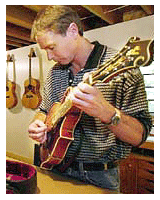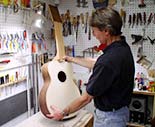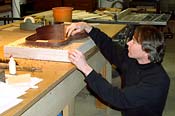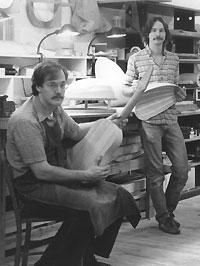

It was a humid September morning in 1977 when I drove up to Farmingdale New York and found James D'Aquisto's workshop, tucked back in a gray, industrial section of Long Island. I was in my teens and had made the long trip over dozens of bridges from Connecticut. His black Chrysler New Yorker hugged the curb. The workshop was surprisingly small. The sharp smell of lacquer and the softer smell of wood filled the air. A couple of D'Angelico's instruments that were in for repair sat on a rack. Jimmy had just finished a beautiful solid body that was on the bench on front of a row of windows. There were a few arch-tops in their molds and some unfinished necks on the table saw. I was in heaven.
 As I showed him a guitar I had just finished, I expressed the difficulties I experienced on the road, as I had much to learn through trial and error. He admitted that his path had never been easy, especially since his teacher, John D'Angelico, died. He examined my guitar closely and talked about the setbacks and obstacles. He had started with just a few hand tools and the spray booth. It had taken him much effort to get on his feet. He played a few chords and then announced that the guitar was "very clean work." I was so relieved! He asked how many I had built. When I told him this was number three, he strummed a few chords and said, "whatever you do, don't stop building." I took his advice and I've been building guitars ever since.
As I showed him a guitar I had just finished, I expressed the difficulties I experienced on the road, as I had much to learn through trial and error. He admitted that his path had never been easy, especially since his teacher, John D'Angelico, died. He examined my guitar closely and talked about the setbacks and obstacles. He had started with just a few hand tools and the spray booth. It had taken him much effort to get on his feet. He played a few chords and then announced that the guitar was "very clean work." I was so relieved! He asked how many I had built. When I told him this was number three, he strummed a few chords and said, "whatever you do, don't stop building." I took his advice and I've been building guitars ever since.
 The days I spent in his workshop are etched in my memory like the pearl inlay on a New Yorker. He showed me how building guitars is both a science and an art - the art of beauty and shape and the science of acoustics. He said, "build with feeling and intuition. Feel the wood, consider density, graining and stiffness and build with that in mind." He said "don't keep doing what every one else like Martin and Gibson has done." He taught me the flat-top bracing technique he called "the circle of sound." He explained how his bracing pattern allows the sound to be contained to the center rather than radiating out to the edge of the guitar and dissipating uselessly. He said it helps the sustain and clarity. I have had great results from this concept. He said "I don't have lutherie secrets, if you can build a better guitar then me, go ahead." He was generous with his time and knowledge.
The days I spent in his workshop are etched in my memory like the pearl inlay on a New Yorker. He showed me how building guitars is both a science and an art - the art of beauty and shape and the science of acoustics. He said, "build with feeling and intuition. Feel the wood, consider density, graining and stiffness and build with that in mind." He said "don't keep doing what every one else like Martin and Gibson has done." He taught me the flat-top bracing technique he called "the circle of sound." He explained how his bracing pattern allows the sound to be contained to the center rather than radiating out to the edge of the guitar and dissipating uselessly. He said it helps the sustain and clarity. I have had great results from this concept. He said "I don't have lutherie secrets, if you can build a better guitar then me, go ahead." He was generous with his time and knowledge.
He was stern when I asked him something more than once. He would say to me "I already told you how to do that. I will only tell you once." I was very attentive after that. I will always be grateful to Jim for his teachings and support. He is a huge part of my building and artistry. I will always be indebted to him for his patience and kindness.
 D'Aquisto taught me to approach instrument making in a unique way: to make instruments with "feeling" as well as science. It is vital that the instrument maker learn the physics of musical instruments, the acoustical properties of vibrating strings, the chemical properties of lacquers and various finishes, and how each type of wood will behave under stress and in different environments. But lutherie is much more than that. D'Aquisto passed something on to me in the form of "internal" knowledge, which is the most valuable form of education that can be imparted from teacher to student. During the process of creation, an intuitive, internal knowledge is transferred from the heart of the maker to the instrument. This direct transference of energy doesn't happen in factory settings or in any type of mass-production. I feel that I am continuing the tradition of D'Aquisto by constructing the instrument as a unified whole from the very beginning, with its sound shaped to the customer's preference.
D'Aquisto taught me to approach instrument making in a unique way: to make instruments with "feeling" as well as science. It is vital that the instrument maker learn the physics of musical instruments, the acoustical properties of vibrating strings, the chemical properties of lacquers and various finishes, and how each type of wood will behave under stress and in different environments. But lutherie is much more than that. D'Aquisto passed something on to me in the form of "internal" knowledge, which is the most valuable form of education that can be imparted from teacher to student. During the process of creation, an intuitive, internal knowledge is transferred from the heart of the maker to the instrument. This direct transference of energy doesn't happen in factory settings or in any type of mass-production. I feel that I am continuing the tradition of D'Aquisto by constructing the instrument as a unified whole from the very beginning, with its sound shaped to the customer's preference.
 I also had an apprenticeship with Lawrence D. Brown, learning the construction techniques of lute making and other Medieval and Renaissance instruments. During that time, I made eleven lutes and a vihuela. Brown is a remarkably gifted luthier who passed on many techniques and traditions that influence my instrument making to this day. I felt that the best way to truly understand the evolution of the modern plucked-string instrument was to look at the work of builders in centuries past, just as modern violin players look to Stradivarius. By building exact replicas of early musical instruments, I was able to gain an understanding of the development of the modern guitar that few other instrument makers possess. When the evolution and development of acoustical guitars becomes really clear, it allows you see just a little way into the future, to make predictions about how guitars will change and improve, and to build guitars which will fulfill the needs and desires of players in ways that no one can anticipate until the finished guitar is placed in the hands of a gifted player. A masterful guitar is the sum total of many things. The study of the changes in historical instruments over many centuries contributes just as much to exceptional playability and tone as intelligent engineering.
I also had an apprenticeship with Lawrence D. Brown, learning the construction techniques of lute making and other Medieval and Renaissance instruments. During that time, I made eleven lutes and a vihuela. Brown is a remarkably gifted luthier who passed on many techniques and traditions that influence my instrument making to this day. I felt that the best way to truly understand the evolution of the modern plucked-string instrument was to look at the work of builders in centuries past, just as modern violin players look to Stradivarius. By building exact replicas of early musical instruments, I was able to gain an understanding of the development of the modern guitar that few other instrument makers possess. When the evolution and development of acoustical guitars becomes really clear, it allows you see just a little way into the future, to make predictions about how guitars will change and improve, and to build guitars which will fulfill the needs and desires of players in ways that no one can anticipate until the finished guitar is placed in the hands of a gifted player. A masterful guitar is the sum total of many things. The study of the changes in historical instruments over many centuries contributes just as much to exceptional playability and tone as intelligent engineering.
To some extent, even Native American traditions are incorporated into my method of instrument making. Wood is from the earth, and therefore contains earth energy, which is the same essence shared by all living things. Feeling the connection with that essence involves listening to what the wood is saying while shaping the sound of the instruments. This lends an almost mystical aspect to the hard science of tap-tones and tuning a soundboard to harmonize with the back and sides.
 In 1987 I had the opportunity to fill the final gaps in my education by traveling to India, where instrument making began thousands of years ago, and studying the ancient history of western musical instruments. This is where it all began. I wanted to learn how builders of instruments half a world away and working from ancient traditions were solving acoustical and mechanical problems. I studied in Calcutta with India's best sitar maker, Hiren Roy. He made Ravi Shankar's sitars.
In 1987 I had the opportunity to fill the final gaps in my education by traveling to India, where instrument making began thousands of years ago, and studying the ancient history of western musical instruments. This is where it all began. I wanted to learn how builders of instruments half a world away and working from ancient traditions were solving acoustical and mechanical problems. I studied in Calcutta with India's best sitar maker, Hiren Roy. He made Ravi Shankar's sitars.
 Old temple paintings and sculptures show that the ancient Indian musicians used almost the same kind of instruments used today. I was building the descendants of instruments that ancient Indian travelers carried across the desert sands and across the Mediterranean Sea into northern Africa. The stringed instruments that the Moors carried into Spain during the invasions of the eighth century would become the lute, the vihuela, the violin, and eventually, the guitar.
Old temple paintings and sculptures show that the ancient Indian musicians used almost the same kind of instruments used today. I was building the descendants of instruments that ancient Indian travelers carried across the desert sands and across the Mediterranean Sea into northern Africa. The stringed instruments that the Moors carried into Spain during the invasions of the eighth century would become the lute, the vihuela, the violin, and eventually, the guitar.
The insights gained from my experience in India completely revolutionized and energized my thinking. The "circle of sound" was now complete for me. I returned to the U.S. and began building instruments as they had never been built before.
I now have a complete guitar workshop in Bearsville, New York. I make unique, custom built guitars as well as other instruments. I provide guitar repair, restoration and setups throughout New York for those interested in luthier quality work. I've setup guitars for many well known musicians and many more that simply play their instruments for local crowds or enjoy it at home. All of my guitar work funnels through my experience. Contact me and we'll talk about your instrument and you.
In 1987 David was recognized by the Ohio Arts Council for his work. He received an Individual Artist Fellowship Grant to develop new musical instruments with innovative designs.